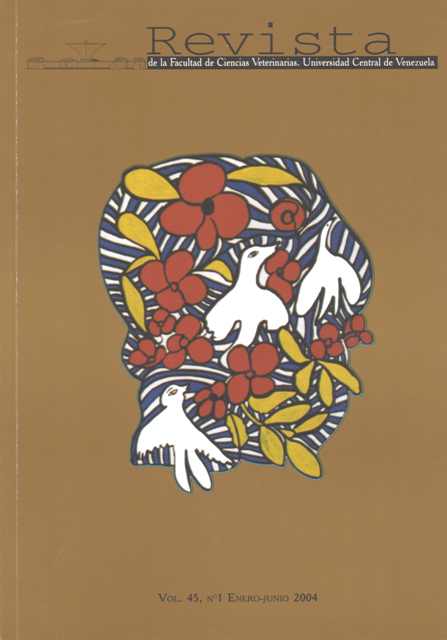COINFECCIÓN DE CIRCOVIRUS PORCINO TIPO 2 CON EL VIRUS DEL SÍNDROME RESPIRATORIO Y REPRODUCTIVO PORCINO EN VENEZUELA
Contenido principal del artículo
Resumen
El circovirus porcino tipo 2 (PCV2) que ha sido asociado al síndrome de emaciación multisistémico postdestete (PMWS), generalmente es diagnosticado conjuntamente con otros agentes infecciosos en cerdos. El virus del síndrome respiratorio y reproductivo porcino (PRRSV) es probablemente el más frecuentemente asociado a estos casos. Aunado a ello, se ha sugerido una potencial relación entre ambos agentes, basándose en infecciones experimentales. Tomando en cuenta que ambos virus, PRRSV y PCV2, han sido detectados en Venezuela, es posible que la coinfección por estos agentes ocurra de forma natural bajo condiciones de campo en el país; en razón de lo cual, el objetivo del presente trabajo fue describir los signos clínicos, las lesiones macroscópicas y microscópicas, así como la detección de ambos virus en cerdos naturalmente coinfectados en Venezuela. Entre noviembre del 2001 y noviembre del 2002, fueron estudiados 27 cerdos entre 6 y 12 semanas de edad, provenientes de 11 granjas, las cuales presentaron capacidades entre 300 y 1.500 madres, estando ubicadas en los estados Aragua, Carabobo, Cojedes, Mérida, Yaracuy y Zulia. Los signos clínicos y las lesiones macro y microscópicas de los cerdos seleccionados fueron registradas. Muestras de tonsila, pulmón, nódulos linfáticos, bazo, hígado, intestino y riñón, fueron fijadas en formalina bufferada al 10% para la realización del examen histopatológico. Los casos compatibles con PMWS fueron procesados según la técnica de hibridación in situ (HIS) para detectar PCV2, realizándose inmunohistoquímica (IHQ) para PRRSV a las muestras positivas a PCV2, de manera de detectar aquellos casos de co–infección viral. De los 27 cerdos con signos clínicos como retraso en el crecimiento y disnea, 10 evidenciaron lesiones microscópicas consistentes con PMWS, de estos últimos, cinco resultaron positivos a la prueba de HIS, tres de ellos (dos con PMWS y uno con infección subclínica de PCV2) se encontraron positivos a PRRSV mediante la prueba de IHQ, siempre con identificación del agente en macrófagos alveolares.
Coinfection of Porcine Circovirus Type 2 with Porcine Reproductive and Respiratory Syndrome virus in Venezuela
ABSTRACT
Porcine circovirus type 2 (PCV2) is usually found concomitantly with other agents in postweaning multisystemic wasting syndrome (PMWS). Among them, porcine reproductive and respiratory syndrome virus (PRRSV) is probably the most frequent one. Furthermore, a potential synergy between those agents has been suggested based on experimental infections. Taking into account that both PRRSV and PCV2 have been detected in Venezuela, it is possible that coinfections by these viral agents occur under field conditions. Therefore, the purpose of this work was to describe the clinical signs, gross lesions observed, histopathological findings and detection of both PCV2 and PRRSV in pigs naturally co-infected with these viruses in Venezuela. Between november 2001 and november 2002, twenty seven 6-12 weekold pigs, taken from eleven farms with 300 to 1500 sows were studied. Herds were located in the states of Aragua, Carabobo, Cojedes, Mérida, Yaracuy and Zulia. Clinical signs and macroscopic lesions of selected pigs were registered. Samples of tonsil, lung, lymph nodes, spleen, liver, intestine and kidney were fixed by immersion in 10% buffered formalin for histopathological examination. Those cases compatibles with PMWS were further processed by in situ hybridization (ISH) to detect PCV2. Finally immunohystochemestry (IHC) for PRRSV detection was only performed in the PCV2 positives samples in order to detect those cases of viral co-infection. Ten out of 27 pigs with clinical signs, growth retardation and respiratory signs, showed microscopic lesions compatible with those of PMWS, five out of these last 10 were positive to ISH to detect PCV2. IHC to detect PRRSV antigen was performed in those 5 PCV2 positive cases. Three of them (two with PMWS and the third with a PCV2 subclinical infection) were found positive to the PRRSV IHC test; labeled cells consisted of alveolar macrophages.
Coinfection of Porcine Circovirus Type 2 with Porcine Reproductive and Respiratory Syndrome virus in Venezuela
ABSTRACT
Porcine circovirus type 2 (PCV2) is usually found concomitantly with other agents in postweaning multisystemic wasting syndrome (PMWS). Among them, porcine reproductive and respiratory syndrome virus (PRRSV) is probably the most frequent one. Furthermore, a potential synergy between those agents has been suggested based on experimental infections. Taking into account that both PRRSV and PCV2 have been detected in Venezuela, it is possible that coinfections by these viral agents occur under field conditions. Therefore, the purpose of this work was to describe the clinical signs, gross lesions observed, histopathological findings and detection of both PCV2 and PRRSV in pigs naturally co-infected with these viruses in Venezuela. Between november 2001 and november 2002, twenty seven 6-12 weekold pigs, taken from eleven farms with 300 to 1500 sows were studied. Herds were located in the states of Aragua, Carabobo, Cojedes, Mérida, Yaracuy and Zulia. Clinical signs and macroscopic lesions of selected pigs were registered. Samples of tonsil, lung, lymph nodes, spleen, liver, intestine and kidney were fixed by immersion in 10% buffered formalin for histopathological examination. Those cases compatibles with PMWS were further processed by in situ hybridization (ISH) to detect PCV2. Finally immunohystochemestry (IHC) for PRRSV detection was only performed in the PCV2 positives samples in order to detect those cases of viral co-infection. Ten out of 27 pigs with clinical signs, growth retardation and respiratory signs, showed microscopic lesions compatible with those of PMWS, five out of these last 10 were positive to ISH to detect PCV2. IHC to detect PRRSV antigen was performed in those 5 PCV2 positive cases. Three of them (two with PMWS and the third with a PCV2 subclinical infection) were found positive to the PRRSV IHC test; labeled cells consisted of alveolar macrophages.
Descargas
Los datos de descargas todavía no están disponibles.
Detalles del artículo
Número
Sección
Artículos de Investigación
